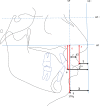Lateral cephalometric analysis of the nasal morphology among Saudi adults
- PMID: 30679927
- PMCID: PMC6338237
- DOI: 10.2147/CCIDE.S190230
Lateral cephalometric analysis of the nasal morphology among Saudi adults
Abstract
Purpose: This study was designed to establish normal values for the nasal form and its relationship to the other cranial structures among male and female skeletal class I Saudi adults. The results of males and females were compared to each other and to the results of a previous study using the same analysis method.
Patients and methods: Sixty-two lateral cephalometric radiographs of Saudi subjects (32 females and 30 males) were retrospectively retrieved from the orthodontic clinical data. Their ages ranged from 20 to 24 years old. All of the cephalometric radiographs were traced manually.
Results: There were statistically significant differences between the Saudi males and females in the nasal length, nasolabial angle, horizontal distance from the nose tip to the incisal edge of the most prominent upper central incisor, and chin. The Saudi males had longer dorsa and increased vertical distances from the pronasale to the chin when compared to the females. The Saudi females had longer vertical distances from the pronasale to the upper lip and larger nasolabial angles when compared to the males. The Saudi males and females had longer noses, longer dorsa, more curved noses (larger supratip break angles), and increased horizontal distances between the nose tip and the chin when compared to a New Zealand sample. The New Zealand sample had increased nasolabial angles, increased nasal tip projection angles, noses significantly projected from the upper lip, the most prominent central incisors, and more prominent maxillae when compared to the Saudi sample.
Conclusion: There were significant differences between the Saudi males and females, as well as between the Saudi sample and the New Zealand sample. These results suggest that both gender and ethnicity must be taken into account when establishing normal values for the nasal form and its relationship to the other cranial structures.
Keywords: lateral cephalometry; nasal analysis; orthodontics; rhinoplasty.
Conflict of interest statement
Disclosure The author reports no conflicts of interest in this work.
Figures


References
-
- Gulsen A, Okay C, Aslan BI, Uner O, Yavuzer R. The relationship between craniofacial structures and the nose in Anatolian Turkish adults: a cephalometric evaluation. Am J Orthod Dentofacial Orthop. 2006;130(2):131.e15–131.e25. - PubMed
-
- Czarnecki ST, Nanda RS, Currier GF. Perceptions of a balanced facial profile. Am J Orthod Dentofacial Orthop. 1993;104(2):180–187. - PubMed
-
- Begg RJ, Harkness M. A lateral cephalometric analysis of the adult nose. J Oral Maxillofac Surg. 1995;53(11):1268–1274. - PubMed
-
- O’Ryan F, Schendel S. Nasal anatomy and maxillary surgery. I. Esthetic and anatomic principles. Int J Adult Orthodon Orthognath Surg. 1989;4(1):27–37. - PubMed
-
- Schendel SA, Carlotti AE., Jr Nasal considerations in orthognathic surgery. Am J Orthod Dentofacial Orthop. 1991;100(3):197–208. - PubMed
LinkOut - more resources
Full Text Sources

